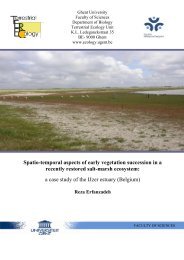PhD Arthur Decae 2010 - Ghent Ecology - Universiteit Gent
PhD Arthur Decae 2010 - Ghent Ecology - Universiteit Gent
PhD Arthur Decae 2010 - Ghent Ecology - Universiteit Gent
You also want an ePaper? Increase the reach of your titles
YUMPU automatically turns print PDFs into web optimized ePapers that Google loves.
Description of male holotype 23<br />
Measurements (mm): total length 17.6, carapace 7.0 long 6.5 wide, sternum 3.5 long 3.5 wide,<br />
lengths legs (measured from bases of paired claws to femur – trochanter junction) I = 22.2, II<br />
= 22.4, III = 21.7, IV = 28.4, length palp 10.0.<br />
Patellar spine formulae: PSP [p=1-1, I=2-2, II=2-2, III=2-2, IV=2-2] RSP [p=0-0, I=1-1, II=1-<br />
0, III=1-1, IV=1-1].<br />
Carapace: (colour in alcohol) distinct pattern with dark head and warm yellow thorax, dark<br />
colour extends from caput over central carapace to caudal edge (Fig. 1), caput moderately<br />
elevated, dense silvery pubescence concentrated on the caudal flanks of caput and irregularly<br />
located elsewhere on carapace, crest-setae in a somewhat irregular row, crest-zone indistinct,<br />
fringe-setae fine procurved on posterior carapace, recurved from coxae III forward, dense<br />
silvery pubescence between fringe-setae on carapace edge. Clypeus: slightly higher than<br />
diameter ALE. Eye-group: eight eyes in two rows, compactly grouped on distinct tubercle,<br />
posterior row longest, periocular pigmentation lighter around AME, shining black connecting<br />
all other eyes. (AR/EL 2.1), (AR/PR 0.9), (ALE/PLE 1.1). Fovea: wide, recurved, central<br />
longitudinal groove indistinct. Chelicerae: dark brown, not contrasting with colour of caput,<br />
strong setae along dorsal crest distally merging with rastellum, zones of dense silvery<br />
pubescence dorsally and laterally, ventrally row of six prolateral furrow teeth, numbers 1, 2<br />
and 5 larger than others (Fig. 3), rastellum well developed, fang-keel serrated. Maxillae:<br />
slightly darker than sternum, (l/w = 1.75), anterior distal process distinct, cuspules spiky<br />
grouped in short rows of four. Sternum: yellow, setae evenly distributed, lateral setae slightly<br />
stronger built, three distinct pairs of sigilla, all placed more than their diameter from edge.<br />
Labium: darker than sternum, shape shorter than wide (l/w 0.5), labial furrow wide and<br />
glabrous. Legs: ventrally yellow grading to darker brown dorsally, spines prominent on all<br />
metatarsi, tibiae, patellae and femora, absent from other segments, trichobothria in irregular<br />
longitudinal row on dorsal tarsi, distinct distal group and proximal row on dorsal metatarsi,<br />
two parallel but alternating rows on dorsal tibiae, scopulae only distinct on ventral tarsi I & II:<br />
all paired claws with two distinct combs of teeth: metatarsi and tibiae of leg I slightly shorter<br />
than of leg II, tibia IV shorter than either metatarsus or femur IV, metatarsus IV slightly<br />
longer than femur IV. Palp: colour, spine and trichobothria patterns as legs. Abdomen: dense<br />
dorsal pattern of irregular dark brown and light yellow patches, ventrally uniformly yellow.<br />
Spinnerets: PMS absent, PLS similar colour as ventral abdomen, basal segment longer than<br />
median and distal segment together, distal segment very short and rounded (domed). Clasper<br />
(Fig. 6): clasper-field of short distally curved spiky hairs on ventral metatarsus I, tibial spur<br />
robust, on prominent tubercle and only slightly curved. Bulb (Fig. 12): long, slender embolus<br />
with sigmoid, denticulate tip.<br />
Description of female paratype:<br />
Specimen female paratype (leg. A. <strong>Decae</strong> 02/07/99-3) deposited, MNHN, AR14314.<br />
Measurements (mm): total length 28.7, carapace 9.4 long 8.3 wide, sternum 5.2 long 4.8 wide,<br />
lengths legs (measured as in holotype) I = 20.8, II = 18.3, III = 18.0, IV = 26.6, length palp<br />
15.0.<br />
Patellar spine formulae: PSP [p=0-0; I=0-0; II=0-0; III=0-0; IV=0-0] RSP [p=0-0; I=0-0;<br />
II=0-0; III=0-0; IV=0-0].<br />
23<br />
The male of this species has recently been described by Cardoso 2000 as the presumed male of N. hispanica.<br />
To avoid confusion we have selected another specimen (than those described by Cardoso) to function as<br />
holotype. The description given here largely overlaps with that of Cardoso 2000 and slight differences noted are<br />
regarded to result from intraspecific morphological variation.










